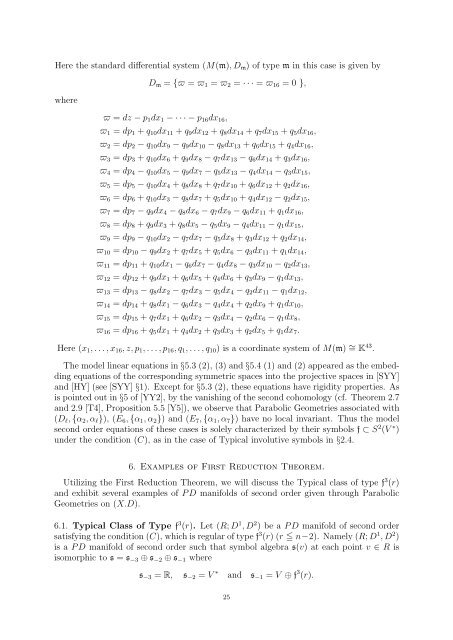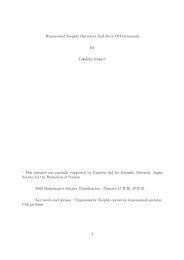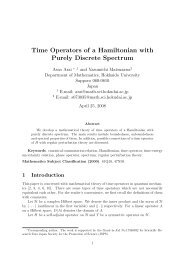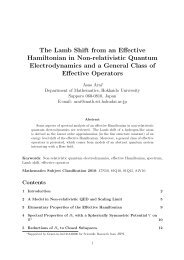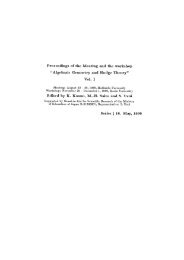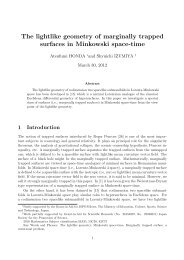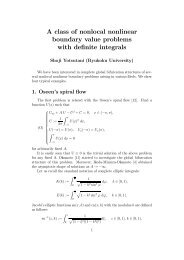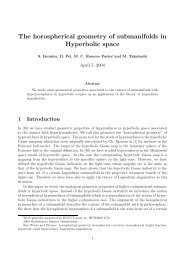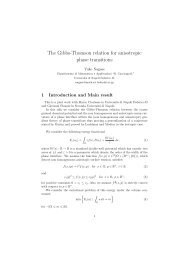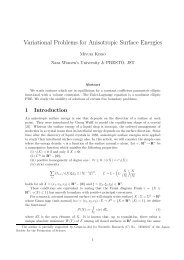Contact Geometry of second order I - Dept. Math, Hokkaido Univ ...
Contact Geometry of second order I - Dept. Math, Hokkaido Univ ...
Contact Geometry of second order I - Dept. Math, Hokkaido Univ ...
You also want an ePaper? Increase the reach of your titles
YUMPU automatically turns print PDFs into web optimized ePapers that Google loves.
Here the standard differential system (M(m), Dm) <strong>of</strong> type m in this case is given by<br />
where<br />
Dm = {ϖ = ϖ1 = ϖ2 = · · · = ϖ16 = 0 },<br />
ϖ = dz − p1dx1 − · · · − p16dx16,<br />
ϖ1 = dp1 + q10dx11 + q9dx12 + q8dx14 + q7dx15 + q5dx16,<br />
ϖ2 = dp2 − q10dx9 − q9dx10 − q8dx13 + q6dx15 + q4dx16,<br />
ϖ3 = dp3 + q10dx6 + q9dx8 − q7dx13 − q6dx14 + q3dx16,<br />
ϖ4 = dp4 − q10dx5 − q9dx7 − q5dx13 − q4dx14 − q3dx15,<br />
ϖ5 = dp5 − q10dx4 + q8dx8 + q7dx10 + q6dx12 + q2dx16,<br />
ϖ6 = dp6 + q10dx3 − q8dx7 + q5dx10 + q4dx12 − q2dx15,<br />
ϖ7 = dp7 − q9dx4 − q8dx6 − q7dx9 − q6dx11 + q1dx16,<br />
ϖ8 = dp8 + q9dx3 + q8dx5 − q5dx9 − q4dx11 − q1dx15,<br />
ϖ9 = dp9 − q10dx2 − q7dx7 − q5dx8 + q3dx12 + q2dx14,<br />
ϖ10 = dp10 − q9dx2 + q7dx5 + q5dx6 − q3dx11 + q1dx14,<br />
ϖ11 = dp11 + q10dx1 − q6dx7 − q4dx8 − q3dx10 − q2dx13,<br />
ϖ12 = dp12 + q9dx1 + q6dx5 + q4dx6 + q3dx9 − q1dx13,<br />
ϖ13 = dp13 − q8dx2 − q7dx3 − q5dx4 − q2dx11 − q1dx12,<br />
ϖ14 = dp14 + q8dx1 − q6dx3 − q4dx4 + q2dx9 + q1dx10,<br />
ϖ15 = dp15 + q7dx1 + q6dx2 − q3dx4 − q2dx6 − q1dx8,<br />
ϖ16 = dp16 + q5dx1 + q4dx2 + q3dx3 + q2dx5 + q1dx7.<br />
Here (x1, . . . , x16, z, p1, . . . , p16, q1, . . . , q10) is a coordinate system <strong>of</strong> M(m) ∼ = K 43 .<br />
The model linear equations in §5.3 (2), (3) and §5.4 (1) and (2) appeared as the embedding<br />
equations <strong>of</strong> the corresponding symmetric spaces into the projective spaces in [SYY]<br />
and [HY] (see [SYY] §1). Except for §5.3 (2), these equations have rigidity properties. As<br />
is pointed out in §5 <strong>of</strong> [YY2], by the vanishing <strong>of</strong> the <strong>second</strong> cohomology (cf. Theorem 2.7<br />
and 2.9 [T4], Proposition 5.5 [Y5]), we observe that Parabolic Geometries associated with<br />
(Dℓ, {α2, αℓ}), (E6, {α1, α2}) and (E7, {α1, α7}) have no local invariant. Thus the model<br />
<strong>second</strong> <strong>order</strong> equations <strong>of</strong> these cases is solely characterized by their symbols f ⊂ S 2 (V ∗ )<br />
under the condition (C), as in the case <strong>of</strong> Typical involutive symbols in §2.4.<br />
6. Examples <strong>of</strong> First Reduction Theorem.<br />
Utilizing the First Reduction Theorem, we will discuss the Typical class <strong>of</strong> type f 3 (r)<br />
and exhibit several examples <strong>of</strong> P D manifolds <strong>of</strong> <strong>second</strong> <strong>order</strong> given through Parabolic<br />
Geometries on (X.D).<br />
6.1. Typical Class <strong>of</strong> Type f 3 (r). Let (R; D 1 , D 2 ) be a P D manifold <strong>of</strong> <strong>second</strong> <strong>order</strong><br />
satisfying the condition (C), which is regular <strong>of</strong> type f 3 (r) (r ≦ n−2). Namely (R; D 1 , D 2 )<br />
is a P D manifold <strong>of</strong> <strong>second</strong> <strong>order</strong> such that symbol algebra s(v) at each point v ∈ R is<br />
isomorphic to s = s−3 ⊕ s−2 ⊕ s−1 where<br />
s−3 = R, s−2 = V ∗<br />
25<br />
and s−1 = V ⊕ f 3 (r).


